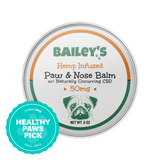Dutch Dog Breeds: Canine Heritage

Dog breeds are an important part of our cultural heritage, and in the case of Dutch dog breeds, they hold a particularly special place in history. Dutch dogs have been valued not just for their working abilities, but also for their loyalty and companionship.

With the help of the friendly experts at Bailey’s CBD , this article explores the rich heritage of Dutch dog breeds, their unique characteristics, popular breeds, training and care, their presence in competitions, and the efforts to conserve and protect these remarkable canines.
Table of Contents
1. Understanding Dutch Dog Breeds
Before diving into the specifics of Dutch dog breeds, it is important to understand their history and unique characteristics.
When it comes to Dutch dog breeds, there is a rich and fascinating history that dates back centuries. The Dutch have always had a deep appreciation for dogs and their abilities, and this is reflected in the careful selection and breeding of these breeds. Throughout the years, Dutch breeders have dedicated themselves to creating dogs that excel in various tasks, from guarding and herding to hunting and even serving as beloved companions for the whole family.
The Dutch have always recognized the value of a good dog, not just as a working partner, but also as a loyal and irreplaceable member of the family. This mindset has driven Dutch breeders to meticulously choose and develop breeds that not only possess the necessary skills for their intended tasks but also exhibit a calm and stable temperament that makes them ideal companions.
Related Dog Breed Article🐕:
Deep-Chested Dog Breeds: Understanding Their Unique Physique and Health1.1 The History of Dutch Dog Breeds
Dutch dog breeds have a long and storied history that dates back centuries. Throughout the years, Dutch breeders have carefully selected and bred dogs to excel in various tasks. These tasks ranged from guarding, herding, hunting, and even serving as companions for the whole family.
The Dutch have always seen their dogs as valuable and irreplaceable companions, so selecting the right breeds for these roles was of utmost importance. Dutch breeders took great care to create dogs that were not only proficient in their original tasks but also possessed a calm and stable temperament.
One of the earliest Dutch dog breeds is the Keeshond, which traces its roots back to the 17th century. Originally bred as a watchdog on barges and farms, the Keeshond is known for its striking appearance, with a thick double coat and expressive eyes. This breed is not only a loyal and protective companion, but also a great family dog.
Another notable Dutch breed is the Dutch Shepherd, which has a long history of herding and guarding livestock. These dogs are brilliant and versatile, making them excellent working dogs in various fields. With their strong and agile bodies, they are well-suited for tasks such as search and rescue, police work, and even competitive dog sports.
Related Dog Breed Article🐕:
Shepherd Breeds: Insights into Canine Herding Traits1.2 Unique Characteristics of Dutch Dogs
Dutch dogs are known for their remarkable loyalty, intelligence, and versatility. They are typically strong and sturdy, with a strong desire to work. Additionally, Dutch dogs are highly adaptable and can thrive in various environments.
These dogs also possess a keen sense of smell, excellent problem-solving skills, and an eagerness to please their owners. While each Dutch breed has distinct traits, these common characteristics make them particularly well-suited for a wide range of jobs and activities.
For example, the Dutch Smoushond, a small and lively breed, is known for its intelligence and agility. Originally bred as a rat-catcher, this breed is now a popular choice for dog sports such as agility and obedience trials. Their quick thinking and willingness to learn make them highly trainable and enjoyable to work with.
On the other hand, the Dutch Barge Dog, also known as the Schipperke, is a small but sturdy breed that was historically used as a watchdog on barges. Despite their small size, these dogs are fearless and protective, making them excellent guard dogs. Their alert nature and high energy levels also make them great companions for active individuals or families.
Whether it's the regal Dutch Shepherd, the charming Keeshond, or the lively Dutch Smoushond, Dutch dog breeds have left their mark in history and continue to be beloved companions and working dogs around the world. Their unique characteristics and rich history make them a fascinating subject of study for dog enthusiasts and historians alike.
Related Dog Breed Article🐕:
English Shepherd: Comprehensive Breed Overview2. Popular Dutch Dog Breeds
Several Dutch dog breeds have gained popularity not just within their home country, but also worldwide. Let's explore three of the most well-known Dutch dog breeds:
2.1 The Dutch Shepherd
The Dutch Shepherd is an incredibly versatile working dog, initially bred for herding sheep. They are energetic, intelligent, and excel in various tasks, including police work, search and rescue operations, and even as service dogs for people with disabilities. Dutch Shepherds are renowned for their loyalty, agility, and strong work ethic.
Originating in the Netherlands, the Dutch Shepherd has a long history of being a reliable and hardworking companion. Their strong herding instincts and natural protective nature make them excellent guardians of livestock and property. These dogs are known for their ability to think independently and make quick decisions, which is why they are often used in demanding roles such as police work.
One of the distinguishing features of the Dutch Shepherd is their coat, which comes in three varieties: short-haired, long-haired, and wire-haired. The short-haired variety is the most common and requires minimal grooming, while the long-haired and wire-haired varieties need regular brushing to prevent matting.
2.2 The Keeshond
The Keeshond, also known as the Dutch Barge Dog, is a charming and affectionate breed. They are known for their fluffy coats and expressive eyes. Keeshonds have historically been companions and watchdogs, providing love and protection to their families. They are highly intelligent and eager to please, making them easy to train and a joy to have around.
Originally bred in the Netherlands as companions on Dutch barges, Keeshonds are known for their friendly and sociable nature. They thrive in the company of their human family and are excellent with children. These dogs are natural watchdogs, always alert and ready to bark to alert their owners of any potential danger.
The Keeshond's thick double coat, which consists of a soft, dense undercoat and a longer, harsher outer coat, provides them with protection from the elements. While their coat requires regular brushing to prevent matting, it also helps to keep them warm in colder climates.
Related Dutch Breed Article🇳🇱:
Dutch Warmblood: Equine Breed Insights2.3 The Stabyhoun
The Stabyhoun, or the Frisian Pointer, is a medium-sized breed known for its friendly and gentle nature. Stabyhouns are exceptional hunting dogs, well-suited for both land and water. They are adaptable, quick learners, and make excellent family pets due to their affectionate and patient nature.
Originating in the Friesland region of the Netherlands, the Stabyhoun has a long history as a versatile hunting dog. They were primarily used for hunting small game, such as birds and rabbits, and their name translates to "stand by me dog," reflecting their ability to point and retrieve game for their owners.
Stabyhouns are known for their calm and patient demeanor, making them great companions for families with children. They are highly trainable and eager to please, which makes them suitable for various dog sports and activities. Their medium-sized build and strong swimming abilities also make them excellent companions for outdoor enthusiasts who enjoy activities such as hiking and swimming.
Recommended for Active Breeds🐕:
Bailey's Hip & Joint CBD Soft Chews for DogsFirst-Time Customer Special: Use code TRYBAILEYS50 for 50% off on your first order!
3. Training and Caring for Dutch Dog Breeds
Training and caring for Dutch dog breeds require a thoughtful approach to ensure their physical and mental well-being. These unique and intelligent canines have specific needs that must be met to keep them happy and healthy.
3.1 Training Techniques for Dutch Breeds
When training Dutch dog breeds, it is important to provide consistent and positive reinforcement. These intelligent canines thrive on praise and motivation rather than harsh punishments. They respond well to reward-based training methods, which focus on positive reinforcement for desired behaviors.
One effective training technique for Dutch breeds is clicker training. This method involves using a small device that makes a distinct clicking sound when pressed. The click is paired with a reward, such as a treat or praise, to reinforce the desired behavior. Dutch dogs quickly learn to associate the click with a positive outcome, making it easier to shape their behavior.
Additionally, mental stimulation is crucial for Dutch dog breeds due to their high intelligence. Engaging them in interactive games, puzzles, and obedience training sessions helps keep their minds sharp and prevents boredom-related behaviors. These dogs excel in activities that challenge their problem-solving skills, such as scent work or agility training.
Related Dog Training Article🐕:
Training with CBD Dog Treats: Tips for Success3.2 Health and Nutrition Needs
Proper nutrition is essential to keep Dutch dogs in optimal health. A balanced diet, formulated specifically for their breed and age, ensures they receive all the necessary nutrients to maintain their energy levels and support their overall well-being. Consult your Dutch dog’s favorite veterinarian about any treats or supplements that may improve your furry friend’s well-being.
When it comes to feeding Dutch dog breeds, it is important to consider their activity level and metabolism. Some Dutch breeds, like the Dutch Shepherd, are highly active and require a diet with higher protein and fat content to fuel their energy. On the other hand, Dutch breeds with a more sedentary lifestyle, such as the Dutch Smoushond, may need a diet with lower calorie content to prevent weight gain.
Regular exercise is also vital for Dutch dogs to prevent obesity and keep them mentally stimulated. Daily walks, play sessions, and activities that tap into their instincts help them lead fulfilling lives and prevent behavioral issues. Dutch breeds, such as the Dutch Kooikerhondje, are known for their love of water, so swimming or retrieving games can be excellent forms of exercise for them.
In addition to physical exercise, socialization is crucial for Dutch dog breeds. These dogs are known for their loyalty and protective nature, but they can also be reserved with strangers. Early socialization with different people, animals, and environments helps them develop into well-rounded and confident dogs.
Professional Dog Training Services🐕🦺:
 K9 Indigo: Expert Training for Your Beloved Canine
K9 Indigo: Expert Training for Your Beloved Canine Discover tailored training programs for your dog's needs, led by experienced professionals at K9 Indigo.
Training and caring for Dutch dog breeds requires a thoughtful and tailored approach. By providing consistent and positive reinforcement, engaging them in mental stimulation activities, and meeting their specific health and nutrition needs, these intelligent canines can thrive and become wonderful companions.

4. Dutch Dog Breeds in Competitions
Due to their exceptional skills and versatile nature, Dutch dog breeds have excelled in various competitive arenas.
4.1 Dutch Breeds in Dog Shows
Dutch dog breeds have made their mark in dog shows around the world. These shows provide an opportunity to showcase their beauty, structure, and adherence to breed standards. Judges evaluate their appearance, movement, and temperament to determine the winners in each category.
Dutch breeds such as the Dutch Shepherd and Keeshond have consistently captivated audiences with their elegance and grace in the show ring.
4.2 Agility and Obedience Competitions
Dutch dogs are frequently seen participating in agility and obedience competitions. Their intelligence, agility, and trainability make them formidable competitors in these events. They navigate obstacle courses, demonstrate obedience, and showcase their skills to the delight of spectators.
Discover Your Pet's Needs🐾:
Take the Bailey's Pet Quiz: Earn a Discount Now!Find the perfect products for your pet and enjoy a special reward for completing our quiz.
Whether it's the quick and nimble Dutch Shepherd or the obedient and graceful Keeshond, Dutch breeds have proven themselves as top contenders in these demanding competitions.
5. The Future of Dutch Dog Breeds
While Dutch dog breeds continue to thrive, efforts are being made to ensure their long-term preservation and conservation.
5.1 Conservation Efforts for Rare Breeds
Several Dutch dog breeds are considered rare, with declining populations. To prevent their extinction and preserve their genetic diversity, dedicated breeders and organizations collaborate to establish breeding programs and promote responsible ownership.
These conservation efforts involve tracking pedigrees, genetic testing, and ensuring proper care and breeding practices. By raising awareness about these rare breeds and encouraging responsible ownership, we can secure a bright future for Dutch dog breeds.
5.2 The Role of Breeders and Kennel Clubs
Breeders play a crucial role in the preservation and improvement of Dutch dog breeds. They meticulously select breeding pairs based on temperament, health, and adherence to breed standards. This ensures the production of healthy puppies with desirable traits.
Related Dog Breed Article🐕:
Big Fluffy Dog Breeds: Discover Their Unique TraitsKennel clubs also have an important role in maintaining breed standards, organizing dog shows, and providing resources and support for breeders and owners.
6. Conclusion
In conclusion, Dutch dog breeds hold a special place in the hearts of many due to their rich heritage and remarkable characteristics. These versatile and intelligent canines have truly captured our admiration and continue to excel in various roles, competitions, and as beloved family pets. Through conservation efforts and responsible ownership, we can ensure that future generations get to experience the joy and companionship of these magnificent Dutch dogs. And owners of these brilliant dogs can enjoy their friendship for long and happy lives with appropriate care, lifestyle, diets, treats, and supplements.Explore More from Bailey's🐕:
 Featured Products:
Related Articles:
Featured Products:
Related Articles:
- Turkish Dog Breeds: Canine Diversity
- Airedale Breed: Traits and Overview
- Black Boxer Dog Breed: Features and Characteristics
- Norwegian Elkhound: Distinct Canine Characteristics
- German Boxer vs. American Boxer: Breed Comparison











